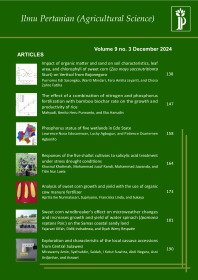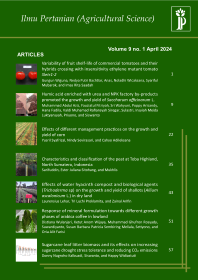
The growth analysis of soybean cultivars on the application of banana pseudo-stem bokashi in Samas Coastal Land, Yogyakarta
Khavid Faozi(1*), Prapto Yudono(2), Didik Indradewa(3), Azwar Ma'as(4)
(1) Department of Agrotechnology, Faculty of Agriculture, Jenderal Soedirman University Jln. Prof. HR. Bunyamin 708, Purwokerto, Central Java
(2) Department of Agronomy, Faculty of Agriculture, Universitas Gadjah Mada Jln. Flora no.1, Bulaksumur, Sleman, Yogyakarta 55281
(3) Department of Agronomy, Faculty of Agriculture, Universitas Gadjah Mada Jln. Flora no.1, Bulaksumur, Sleman, Yogyakarta 55281
(4) Department of Soil Science, Faculty of Agriculture, Universitas Gadjah Mada Jln. Flora no.1, Bulaksumur, Sleman, Yogyakarta 55281
(*) Corresponding Author
Abstract
A coastal sandy land is a potential land used for soybean cultivation. The success in developing soybeans in coastal sandy land depends on the suitability of cultivars used and the cultivation technology applied. Therefore, this study aimed to analyze the growth of twelve soybean cultivars in coastal sandy land as affected by the application of banana pseudo-stem bokashi. The experiment was carried out in factorial randomized complete block design with three replications. The treatment factors consisted of rates of bokashi (0, 20, 40, and 60 ton.ha-1) and 12 soybean cultivars (Anjasmoro, Argomulyo, Burangrang, Demas 1, Dena 1, Devon 1, Gamasugen 1, Gema, Gepak Ijo, Grobogan, Kaba, and Slamet). The net assimilation rate, relative growth rate, and root and shoot dry weight were affected by the bokashi rates, with varying responses according to the soybean cultivar. Demas 1 cultivar was the most adaptive cultivar in coastal sandy land based on its ability to accumulate dry matter of plants. The accumulation of dry matter of roots and shoots increased with bokashi application and the optimum rate were 42.83 ton.ha-1 and 45.56 ton.ha-1, respectively.
Keywords
Full Text:
PDFReferences
Adie, M.M., Krisnawati, A., and Harnowo, D. (2015). Keragaman dan pengelompokan galur harapan kedelai di Kabupaten Sleman, Yogyakarta. Prosiding Seminar Nasional Masyarakat Biodiversitas Indonesia, pp. 787-791.
Adijaya, I.N., Suratmini, P., and Mahaputra, K. (2005). Aplikasi pemberian legin (rhizobium) pada uji beberapa varietas kedelai di lahan kering. [online]. Available at: http://www.ntb.litbang.deptan.go.id/2005/THP/aplikasipemberian.doc. [Accessed 12 June 2014].
Anten, N.P.R. and Ackerly, D.D. (2001). A new method of growth analysis for plants that experience periodic losses of leaf mass. Functional Ecology, 15(6), pp. 804-811.
A new method of growth analysis for plants that
experience periodic losses of leaf mass
Badan Pusat Statistik. 2020. Impor-kedelai-menurut-negara-asal-utama-2010-2019. [online]. Available at: https://www.bps.go.id/statictable/2019/02/14/2015/impor-kedelai-menurut-negara-asal-utama-2010-2019.html. [Accessed 12 December 2018]
Barus, M., Rogomulyo, R., and Trisnowati, S. (2013). Pengaruh takaran pupuk kandang terhadap pertumbuhan dan hasil wijen (Sesamum indicum L.) di lahan pasir pantai. Vegetalika, 2(4), pp. 45-54.
Cyio, M.B. (2006). Analisis tingkat kesuburan tanah entisol akibat pemberian bahan organik yang diinkubasi melalui pendekatan indeks biokimia. Agroland, 13(4), pp. 337-342.
Elnour, M.E.M., Elfadil, A.G., Manal, F.A., and Saeed, B.A.E. (2015). Effects of banana compost on growth, development and productivity of Sorghum bicolor cultivar (tabat). Journal Of Advances In Biology, 8(2), pp. 1554-1561.
Faozi, K., Yudono, P., Indradewa, D., and Ma’as, A. (2016). Peluang pengembangan kedelai di lahan pasir pantai. Prosiding Seminar Nasional dan Call For Papers “Pengembangan Sumberdaya Perdesaan dan Kearifan Lokal Berkelanjutan VI”, pp. 241-254.
Faozi, K., Yudono, P., Indradewa, D., and Ma’as, A. (2019). Serapan hara N,P,K dan hasil biji kedelai (Glycine max L. merrill) pada pemberian bokashi pelepah pisang pada tanah pasir pantai. Vegetalika, 8(3), pp. 177-191.
Faozi, K. (2018). Pertumbuhan dan hasil kedelai pada pemberian bokashi pelepah pisang dan pupuk fosfor di lahan pasir pantai. Dissertation. Universitas Gadjah Mada Yogyakarta.
Francisco, E., Câmara, G., Casarin, V., and Prochnow, L. (2014). Increasing soybean yields: Brazil’s challenges. Better Crops, 98(2), pp. 20-23.
Hall, D.J.M., and Bell, R.W. (2015). Biochar and compost increase crop yields but the effect is short term on sandplain soils of Western Australia. Pedosphere, 25(5), pp. 720–728.
Hoa, H.T.T, Cong, P.T., Tam, H.M., Chen, W., and Bell, R. (2010). Sandy soils in South Central Coastal Vietnam: Their origin, constraints and management. 19th World Congress of Soil Science, Soil Solutions for a Changing World, pp. 251-254.
Johnston, A.E. (2007). Soil organic matter, effects on soils and crops. Soil Use and Management, 2(3), pp. 97–105.
Kusumawati, A. (2015). Analisa karakteristik pupuk kompos berbahan batang pisang. Prosiding Seminar Nasional Universitas PGRI Yogyakarta 2015, pp. 322-328.
Li, K., Fu, S., Zhan, H., Zhan, Y., and Lucia, L.A. (2010). Analysis of the chemical composition and morphological structure of banana pseudo-stem. BioResources, 5(2), pp. 576-585.
Pagano, M.C. and Miransari, M. (2016). The importance of soybean production worldwide. In: M. Miransari, ed., Abiotic and Botic Stresses in Soybean Production: Soybean Production Volume One. Cambrigde USA: Academic Press, pp. 1-26.
Pandey, R., Paul, V., Das, M., Meena, M., and Meena, R.C. (2017). Plant growth analysis. In: V. Paul, R. Pandey, M. Pal, eds., Manual of ICAR Sponsored Training Programme on “Physiological Techniques to Analyze the Impact of Climate Change on Crop Plants". New Delhi: Division of Plant Physiology, IARI., pp. 103-107.
Patle, G.T., Sikar, T.T., Rawat, K.S., and Singh, S.K. (2019). Estimation of infiltration rate from soil properties using regression model for cultivated land. Geology, Ecology, and Landscapes, 3(1), pp. 1-13
Purwaningsih, O., Indradewa, D., Kabirun, S., and Shiddieq, D. (2012). Tanggapan tanaman kedelai terhadap inokulasi rhizobium. Agrotrop, 2(1), pp. 25-32.
Rajiman, Yudono, P., Sulistyaningsih, E., and Hanudin, E. (2008). Pengaruh pembenah tanah terhadap sifat fisika tanah dan hasil bawang merah pada Lahan Pasir Pantai Bugel Kabupaten Kulon Progo. Agrin, 12(1), pp. 67-77.
Ramos, J.C., Imhoff, S.D.C., Pilatti, M.Á., and Vegetti, A.C. (2010). Morphological characteristics of soybean root apexes as indicators of soil compaction. Scientia Agricola, 67(6), pp. 707-712.
Ratnasari, S., Putra, E.T.S., and Indradewa, D. (2017). Analysis of the growth of oil palm (Elaeis guineensis Jacq.) exposed by aluminum toxicity and silica as an amelioration. Ilmu Pertanian (Agricultural Science), 2(1), pp. 015-019.
Salvagiotti, F., Cassman, K.G., Specht, J.E., Walters, D.T., Weiss, A., and Dobermann, A. (2008). Nitrogen uptake, fixation and response to fertilizer N in soybeans: A review. Field Crops Research, 108(1), pp. 1–13.
Sitompul, S.M and B. Guritno. (1995). Analisis pertumbuhan tanaman. 1st ed., Yogyakarta: Gadjah Mada University Press, pp. 125-210
Sumarno and Adie, M. (2011). Strategi pengembangan produksi menuju swasembada kedelai berkelanjutan. Makalah kebijakan. Inovasi teknologi untuk pengembangan kedelai menuju swasembada. Prosiding Seminar Nasional Hasil Penelitian Tanaman Aneka Kacang dan Umbi, pp. 17-28.
Syukur,A. and Harsono, E.S. (2008). Pengaruh pemberian pupuk kandang dan NPK terhadap beberapa kimia dan fisika tanah Pasir Samas, Bantul. Jurnal Ilmu Tanah dan Lingkungan, 8(2), pp. 138-145.
Article Metrics
Refbacks
- There are currently no refbacks.
Ilmu Pertanian (Agricultural Science) ISSN 0126-4214 (print), ISSN 2527-7162 (online) is published by Faculty of Agriculture Universitas Gadjah Mada collaboration with Perhimpunan Sarjana Pertanian Indonesia (PISPI) and licensed under a Creative Commons Attribution-ShareAlike 4.0 International License.













